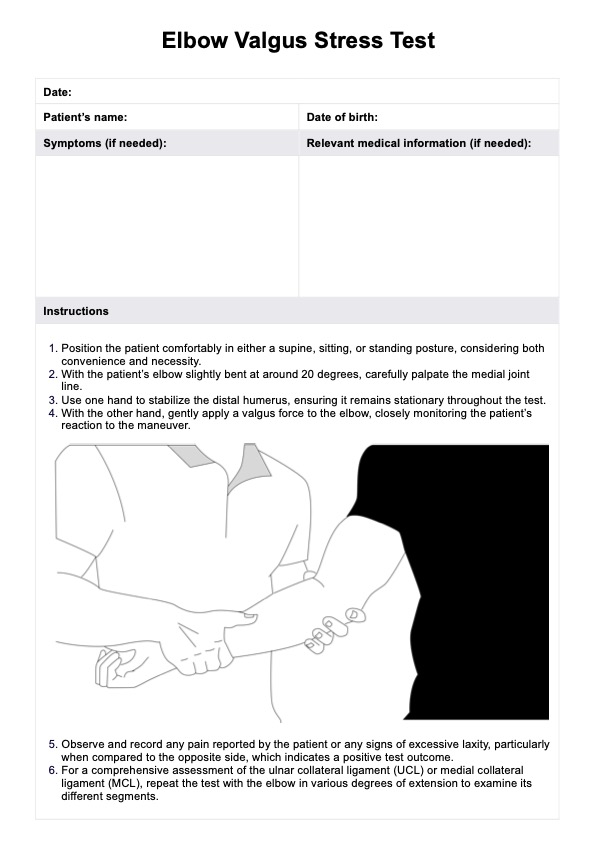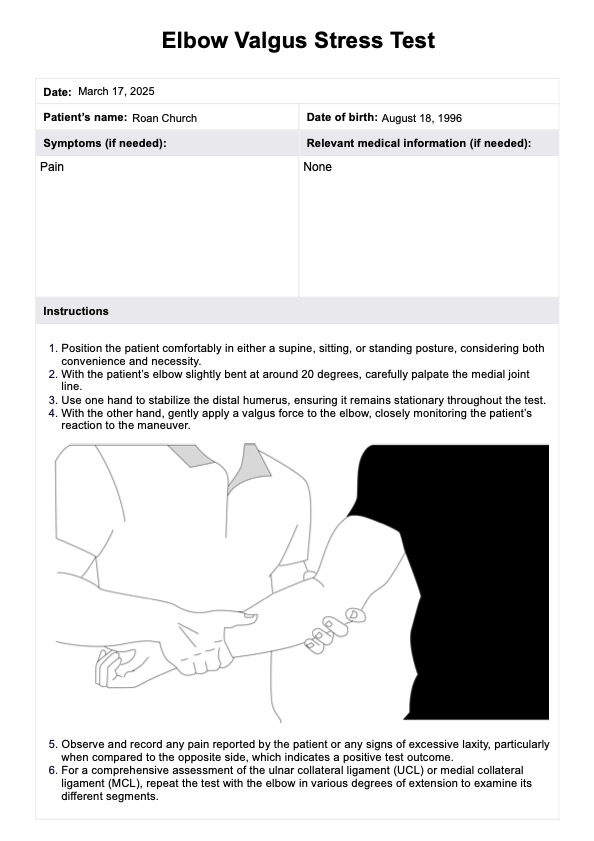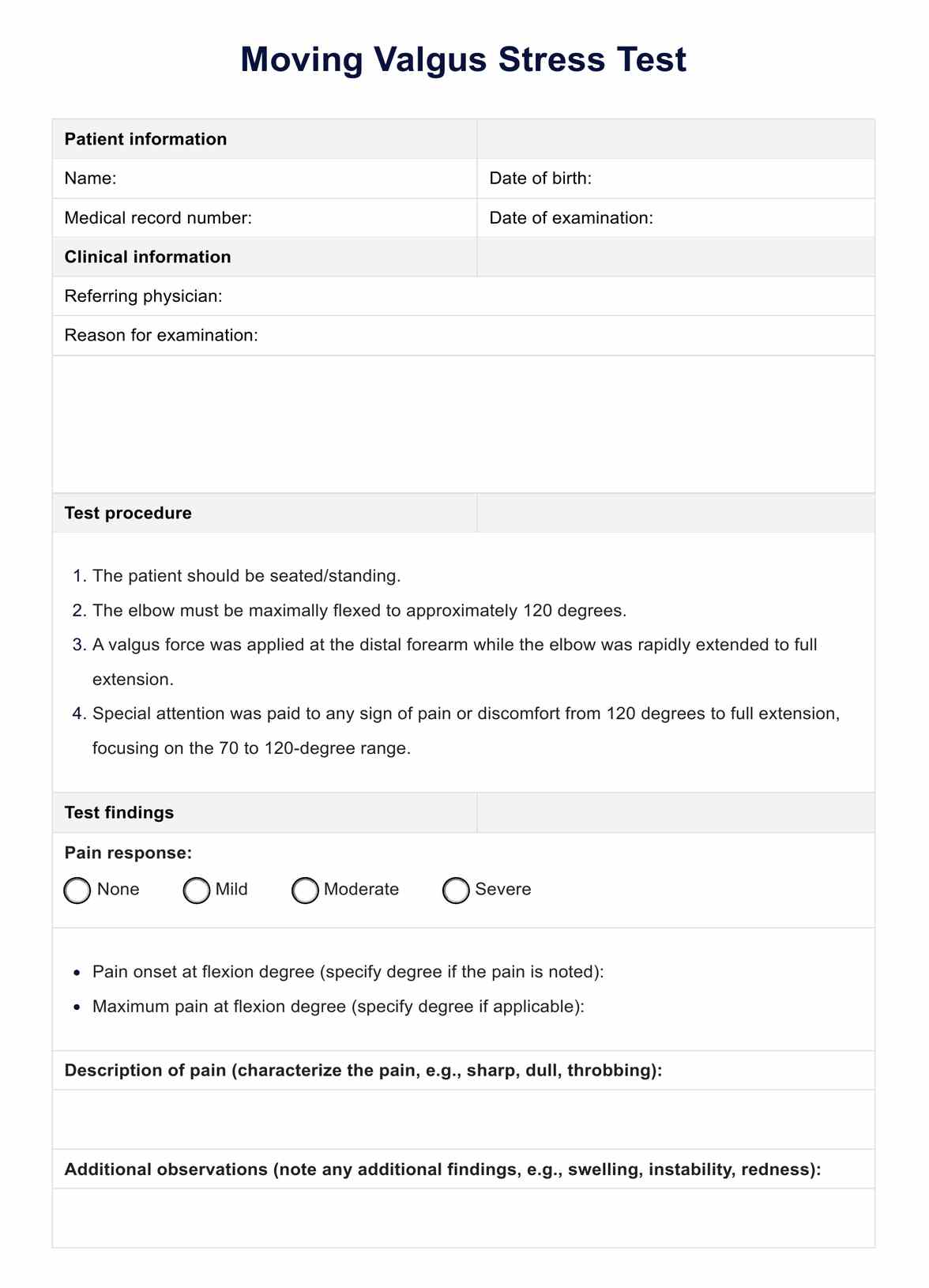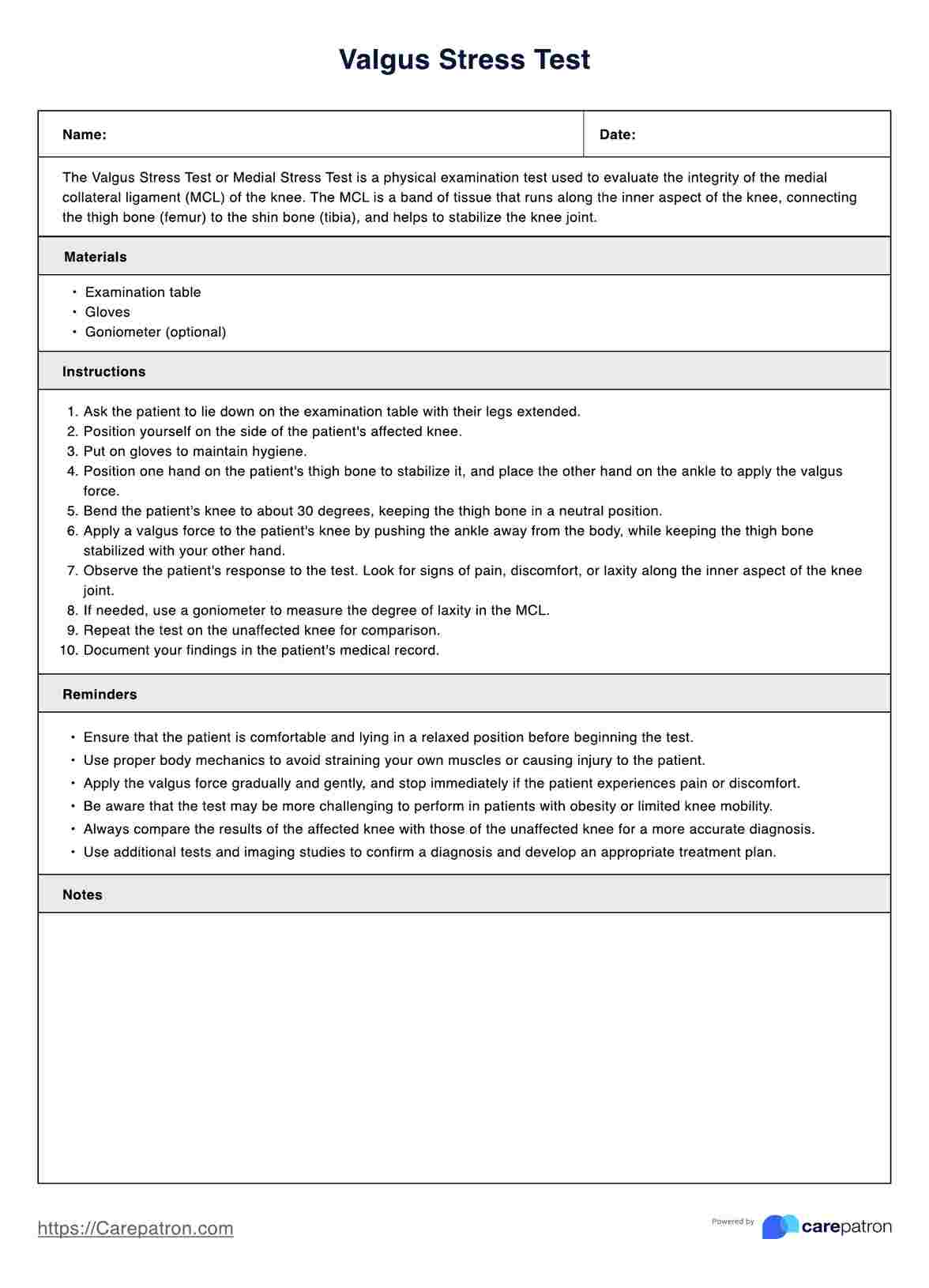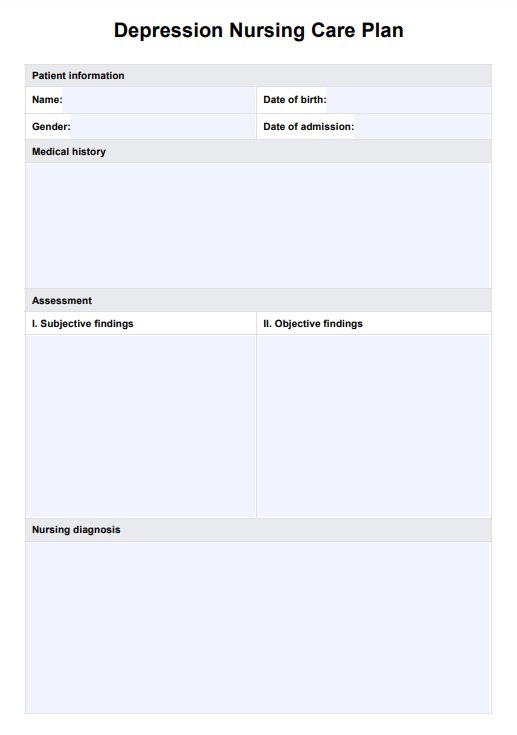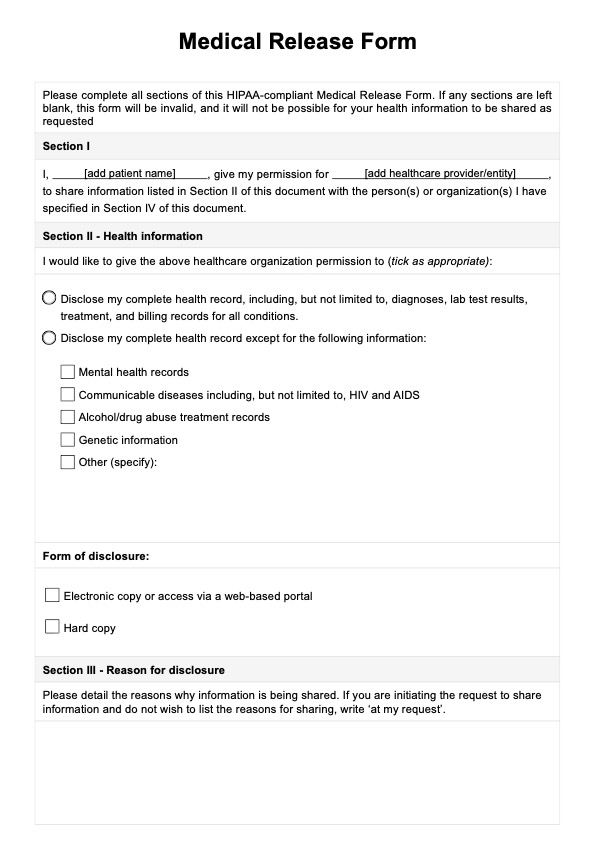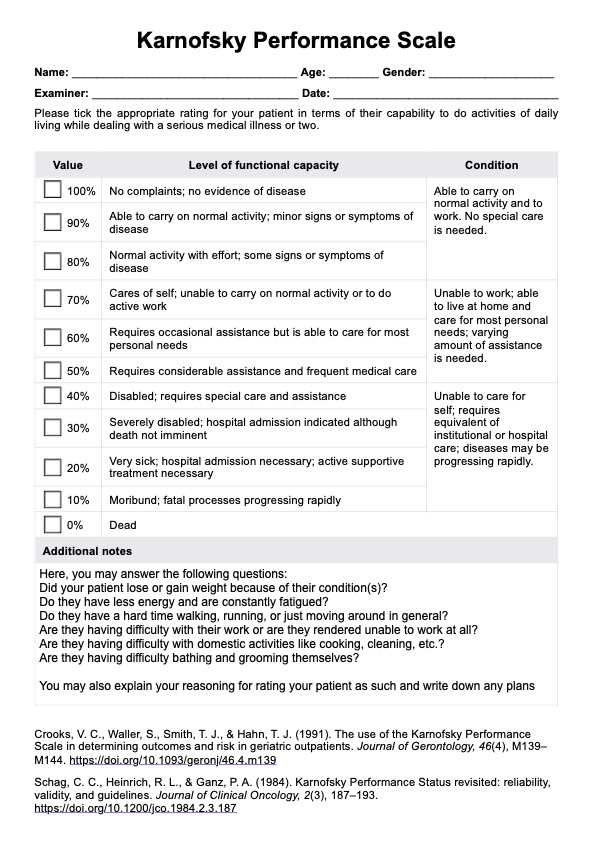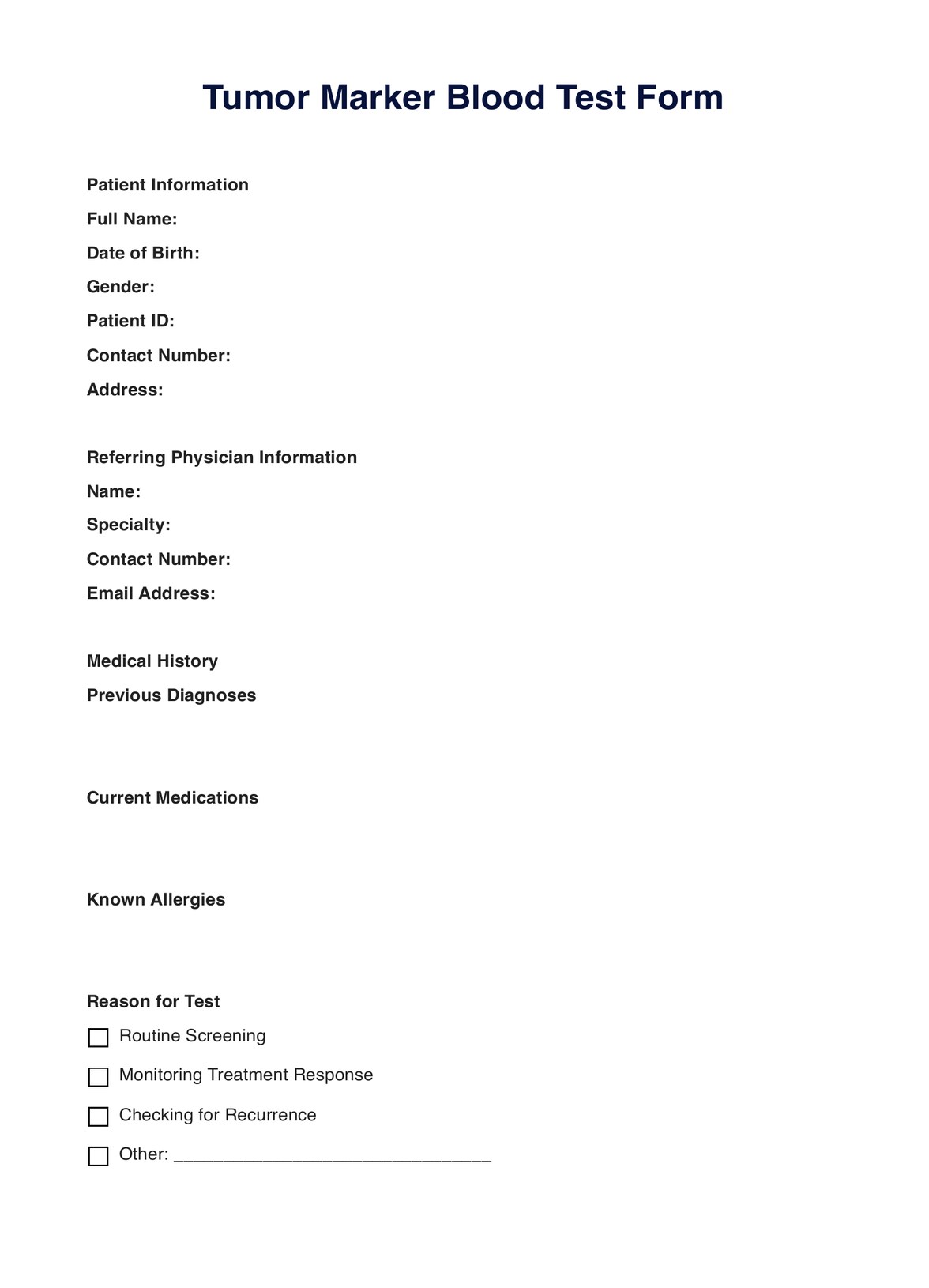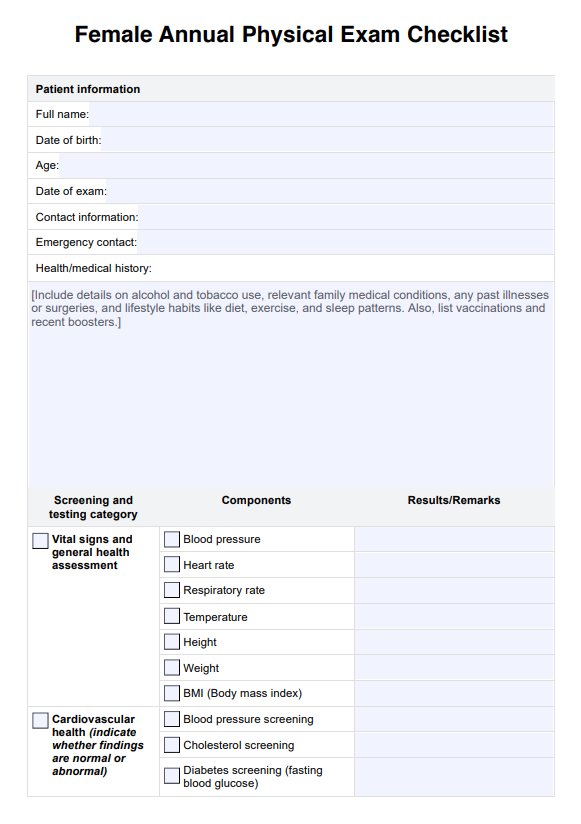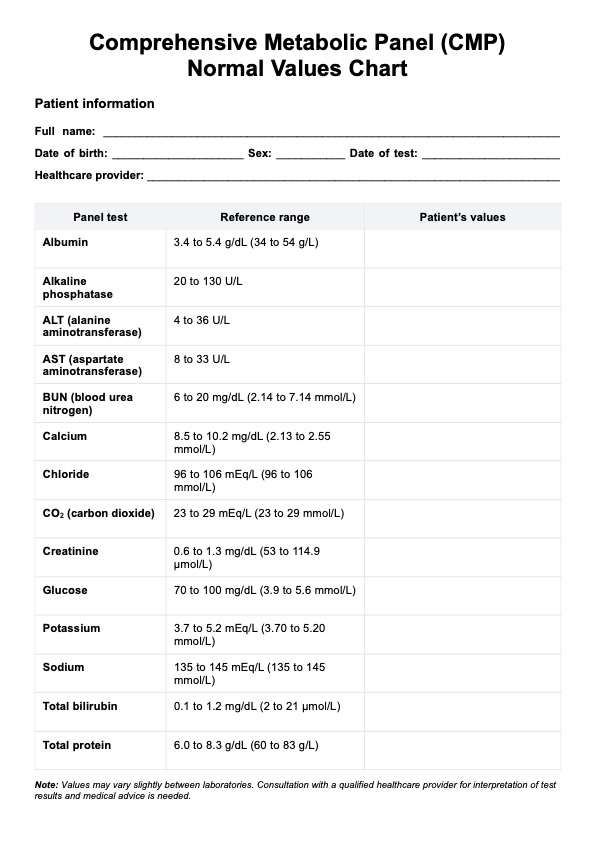Elbow Valgus Stress Test
Better assess the stability and integrity of your patient's UCL or MCL with an Elbow Valgus Stress Test. Get a free PDF template and example in this guide.


What is a UCL injury?
An ulnar collateral ligament (UCL) injury, also known as a medial collateral ligament (MCL) injury, is damage to the ulnar collateral ligament, a band of tissue that connects the humerus (upper arm bone) to the ulna (bone in the forearm). The UCL's anterior and posterior bands provide stability to the elbow joint, preventing it from excessive side-to-side movement. When these bands are overstretched or torn, it can result in pain, weakness, and instability in the elbow.
A UCL injury can occur due to repetitive stress on the elbow or from a sudden traumatic event such as a fall. UCL or MCL injuries are common among athletes participating in overhead-throwing sports such as baseball, softball, and tennis.
Symptoms
Some of the common symptoms of a UCL injury include:
- Pain and tenderness on the inner side of the elbow
- Swelling and stiffness around the elbow joint
- Difficulty with gripping or throwing objects due to weakness in the arm
- Numbness or tingling sensations in the ring and little fingers are supplied by the ulnar nerve that runs through the UCL.
Individuals may also experience a popping sound during the injury, followed by difficulty with arm movements. In severe cases, there may be bruising or discoloration around the elbow joint.
How to diagnose a UCL injury
To diagnose injuries to the MCL, the doctor will first perform a physical examination and review the patient's medical history. They may also order imaging tests such as X-rays, computed tomography (CT) scans, and magnetic resonance imaging (MRI) scans, which are medical imaging techniques used to evaluate the severity of an injury by providing detailed images of the inside of the body.
In some cases, a stress test like the Elbow Valgus Stress Test, in which the doctor applies pressure to the inner side of the elbow while bending and straightening the arm, may be performed to assess the stability of the UCL.
Elbow Valgus Stress Test Template
Elbow Valgus Stress Test Example
What is the Elbow Valgus Stress Test?
The Elbow Valgus Stress Test is a medical procedure used to assess the integrity and stability of the UCL or MCL. It is commonly performed on athletes, especially those involved in throwing sports such as baseball or javelin.
To perform the valgus stress test for the elbow, the patient sits comfortably on an examination table with their arm resting on a flat surface. The examiner positions the elbow in 20° to 30° of flexion with the forearm supinated. One hand is placed above the elbow joint to stabilize the upper arm, while the other is positioned just below it. The examiner then applies a valgus stress to the elbow by gently pushing the forearm outward while stabilizing the upper arm.
The test is considered positive if there is no firm end point, greater than 1 mm of medial joint opening (fluoroscopically), or reproduction of the patient’s pain, which may indicate a UCL injury and valgus instability. The examiner may also perform the test on the unaffected arm for comparison.
How does our Elbow Valgus Stress Test template work?
Carepatron's free Elbow Valgus Stress Test template is designed to help healthcare professionals perform this elbow stability test accurately and efficiently for improved clinical documentation. Follow these steps to get started:
Step 1: Download the template
Get a copy of the printable Elbow Valgus Stress Test by clicking the "Use template" button. You can also get it from our handy resources library, which includes other physio tests like the Shrug Test, MCL Injury Test, and more.
Step 2: Print or use the digital format
You can choose to print the template and have it ready in your clinic for easy access during consultations. Alternatively, you can use our digital format on the Carepatron app to complete the test directly on your device.
Step 3: Conducting the test
Follow the instructions in the template to perform this stress test properly. Note any pain or excessive movement during the test, which could indicate a UCL injury.
Step 4: Record your findings
Use the designated space on the template to record your patient's responses and any other observations made during the test. This will help with accurate clinical documentation and treatment planning.
Step 5: Share or save
You can easily save your completed template on the Carepatron app for future reference or share it with colleagues and other healthcare providers involved in your patient's care.
Treatment options for valgus instability
Patients with a UCL injury will typically undergo nonsurgical treatment first, which includes rest, ice, compression, and physical therapy. If these methods do not provide relief or if the injury is severe, surgery may be required.
Surgery for UCL injuries typically involves ulnar collateral ligament reconstruction, which consists of using a graft to replace the damaged ligament. After this elbow surgery, patients must undergo physical therapy and rehabilitation to recover fully.
Healthcare professionals recommend that patients refrain from activities that may aggravate the injury, especially throwing sports, until they have fully healed. Patients should also follow their treatment plan and attend all recommended follow-up appointments to ensure proper healing and prevent future injuries.
Benefits of our free template
Our Elbow Valgus Stress Test template is helpful for healthcare professionals looking to document and track UCL injuries in their patients accurately. Here are some of its advantages:
Fully digital
Our template is available in a fully digital format, making it easily accessible and editable. This allows you to quickly fill out the necessary information and save it for future reference.
Customizable
You can easily customize our template to fit your specific needs and preferences. You can add or remove sections, change the formatting, and even include your branding.
Easy to use
Our template is designed to be user-friendly and straightforward. This makes it easy for healthcare professionals of all experience levels to utilize it effectively.
Comprehensive
Our template includes all the necessary sections and information for accurately documenting UCL injuries. With our comprehensive template, you can ensure you capture all relevant details.
Commonly asked questions
The medial collateral ligament (MCL) and the ulnar collateral ligament (UCL) are the same ligaments, referred to by different names. Located along the medial joint line of the elbow, it plays a vital role in maintaining elbow stability by preventing excessive lateral displacement of the ulna.
Yes, ulnar collateral ligament (UCL) injuries can significantly impact elbow extension and stability. Injuries to this ligament can result in pain, weakness, and limited range of motion in the elbow joint.
Yes, elbow flexion and supination can also be impacted by UCL injuries. When the ligament is damaged, bending the elbow or rotating the forearm can be difficult.


